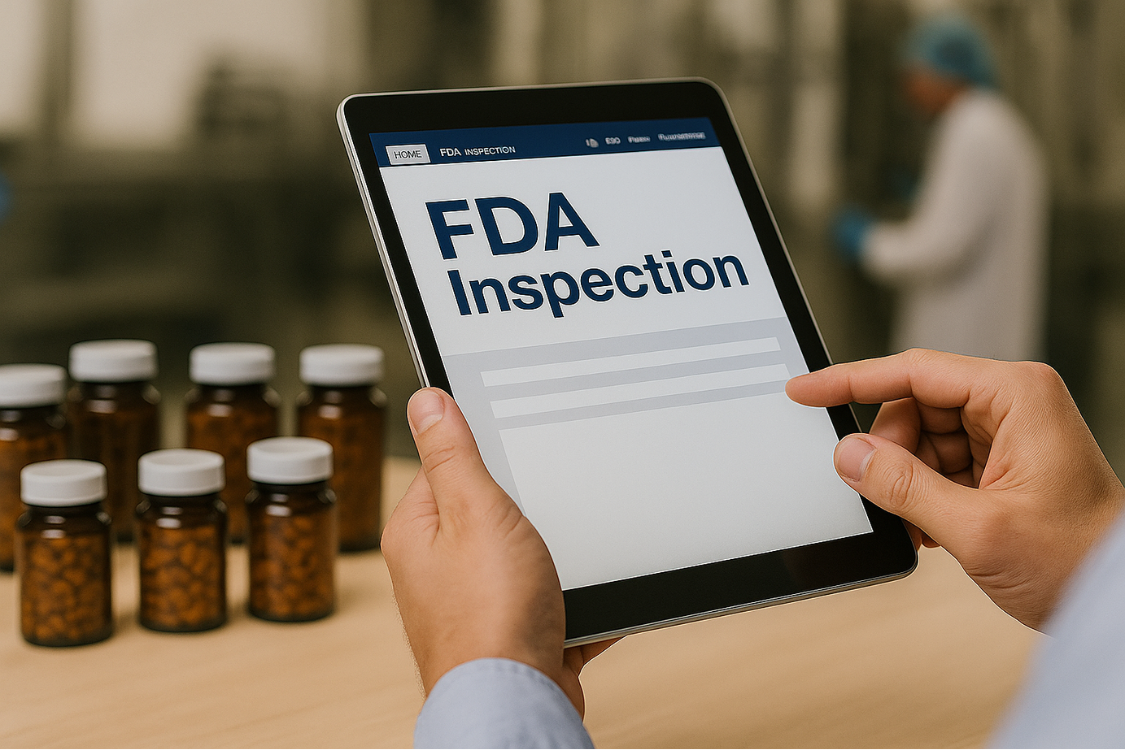How much do you really know about the company making your supplements? Choosing the wrong partner can put your brand’s reputation and customer trust at risk. One of the clearest ways to measure a manufacturer’s reliability is by looking at their FDA (Food and Drug Administration) inspection history and supplement manufacturer records.
These inspections assess whether a facility follows required regulations designed to help ensure dietary supplement products are manufactured under proper standards. A poor record can indicate issues such as recalls, fines, or enforcement actions that could harm your business.
Checking a manufacturer’s inspection history is not complicated, but it does require knowing where to look and how to interpret the results. The goal is straightforward: provide yourself with the information you need to make confident, informed decisions about who to trust for producing your supplements.
Why FDA Inspection History Matters for Supplement Brands
An FDA inspection history supplement manufacturer record provides a clear picture of how a company operates. It indicates whether they meet safety standards and adhere to the rules established for the dietary supplement industry. This background check helps you avoid unnecessary risks when choosing a partner for your brand.
What FDA inspections reveal about a manufacturer
Most inspections are planned as surveillance visits or follow-ups conducted by FDA investigators, though the agency may also conduct for-cause inspections when concerns arise. These checks examine quality systems, labeling, documentation, and how a facility manages each dietary ingredient. Inspection data also indicates whether the company is prepared for audits and whether its compliance programs can withstand external review.
How non-compliance can impact your brand
Failing to comply with dietary supplement regulations can lead to serious consequences. Companies that fail inspections may receive FDA warning letters, face product seizures, or be cited in inspectional observations, such as Form FDA 483. Non-compliance can also lead to recalls of dietary supplement products, which damage customer trust and create financial strain. For a brand owner, even one incident involving adulterated dietary supplements can weaken credibility and hurt long-term growth.

How to Check a Supplement Manufacturer’s FDA Inspection History
You can verify a company’s compliance record with just a few steps. The FDA provides public tools to review inspection results, enforcement actions, and warnings sent to dietary supplement companies. Knowing how to use these databases helps you identify safe partners and avoid manufacturers with a poor compliance track record.
Step 1: Go to the FDA Inspection Database
The FDA hosts the Inspection Classification Database. You can search by company name, city, or state to see recent visits conducted at a facility. Results include inspection date, classification, and status. Reviewing this database is the first step in confirming a manufacturer’s standing.
Step 2: Understand inspection classifications
The results you’ll see fall into three categories:
- NAI (No Action Indicated): No major issues found, the facility meets standards.
- VAI (Voluntary Action Indicated): Minor problems were observed, but the company remains compliant.
- OAI (Official Action Indicated): Serious problems were documented, and the FDA may pursue enforcement.
Understanding these classifications helps you determine whether the company is safe to work with or if follow-up is needed.
Step 3: Look for warning letters or enforcement actions
A clean database entry does not always tell the whole story. Check the FDA’s Warning Letters Database for letters issued to the company. These letters show what violations were found, the corrective actions required, and how the company chose to respond. Repeated letters suggest weak internal audits or poor management of compliance programs.
Step 4: Confirm other certifications
FDA inspections are one measure, but not all manufacturers stop there. Reliable companies often carry certifications from NSF, ISO, or state agencies to ensure compliance with more detailed requirements. Checking for these credentials gives extra confidence that the facility prioritizes product safety, labeling accuracy, and regulatory standards across the supplement industry.

What a Clean FDA Record Means for Your Brand
A clean inspection history shows that a company understands the rules and respects regulatory compliance. It reflects a culture of quality, proper documentation, and strong internal audits. Brands that choose such partners enjoy smoother operations and fewer surprises.
Stability and reliability
Manufacturers with consistent compliance records usually have stronger quality systems in place. They run tighter processes, maintain accurate reporting, and have fewer disruptions during audits or inspections. This stability allows your business to focus on growth instead of damage control.
Lower risk for recalls and product delays
A good inspection history suggests a lower likelihood of issues such as recalls, adverse events, or halted shipments, based on how the company has met compliance standards in the past. When a facility already meets federal standards during a surveillance inspection, production schedules are less likely to be interrupted and overall product quality remains consistent. This reliability supports stronger brand trust and aligns with regulatory standards intended to protect public health, leading to the clear conclusion that choosing a compliant manufacturer safeguards both your reputation and long-term stability.
Red Flags to Watch for in FDA Inspection Records
Not all inspection results should be treated the same, since some findings are classified as more serious than others. Spotting these warning signs early helps you avoid manufacturers that may put your brand and even dietary supplement health claims at risk. Limited resources at the FDA mean not every facility is reviewed frequently, so brands must rely on their own supplier qualification program to screen potential partners and ensure ongoing compliance with interstate commerce rules.
Repeated OAI classifications
If a company has had multiple OAI classifications in recent years, it signals major compliance failures. A pattern like this often means the facility has not corrected problems, even after receiving official notices or facing enforcement.
Frequent warning letters
Repeated warning letters show a manufacturer is not learning from past mistakes. This may also indicate poor corrective actions or a lack of resources to maintain compliance with dietary supplement regulations.
Lack of transparency from the manufacturer
When a company avoids sharing inspection records or limits access to compliance reports, that’s a red flag. Trustworthy partners are open about their inspection history and can provide examples of corrective actions and compliance programs.

How to Discuss FDA Inspection History With Your Manufacturer
Checking databases is important, but conversations with your supplier matter just as much. Clear communication builds trust and ensures both sides are aligned on compliance expectations.
Questions to ask during due diligence
Asking direct questions helps uncover details that a database entry may not show:
- When was your last FDA inspection?
- Have you ever received a warning letter?
- What steps do you take to stay compliant with dietary supplement regulations?
Why honest conversations matter
Reputable manufacturers welcome these questions and provide documentation to back up their answers. They should also share how they conduct internal audits, address FDA observations, and handle corrective actions. A company that avoids these topics may not be the right partner for your brand.
Protect Your Brand by Checking FDA Records
Your choice of manufacturer shapes the future of your business. Reviewing a supplement manufacturer’s FDA inspection history gives you a clear view of their compliance, use of Good Manufacturing Practices, and overall approach to product safety. The Food and Drug Administration’s inspection databases and FDA warning letters provide essential information about how dietary supplement companies operate and respond to regulatory oversight. A partner with a clean record signals stability, reliable quality systems, and lower risk of recalls or enforcement actions. Take the time to check inspection data and confirm certifications, because doing so ensures your supplements meet the highest standards and protects your brand’s reputation for the long term.
Frequently Asked Questions
What is an FDA inspection history for supplement manufacturers?
It is the official FDA record showing how a supplement manufacturer complies with dietary supplement regulations and Good Manufacturing Practices.
How do I check a supplement manufacturer’s FDA inspection record?
You can search the FDA Inspection Classification Database using the company’s name, city, or state to review inspection data.
What do NAI, VAI, and OAI mean in FDA inspection results?
These are FDA classifications where NAI means no issues, VAI means minor voluntary fixes, and OAI signals serious compliance problems.
What happens if a supplement manufacturer has an OAI classification?
An OAI classification means FDA enforcement may follow, so you should ask about corrective actions or consider other manufacturers.
Do all dietary supplement companies go through FDA inspections?
All dietary supplement facilities fall under FDA authority and may be inspected, though not every facility is visited regularly due to resource and scheduling priorities.
References
- U.S. Food and Drug Administration. (2024, September 13). Inspection Classification Database. U.S. Department of Health and Human Services. Content current as of 09/13/2024. https://www.fda.gov/inspections-compliance-enforcement-and-criminal-investigations/inspection-classification-database
- U.S. Food and Drug Administration. (2025, September 9). Warning Letters. U.S. Department of Health and Human Services. Content current as of 09/09/2025. https://www.fda.gov/inspections-compliance-enforcement-and-criminal-investigations/compliance-actions-and-activities/warning-letters




